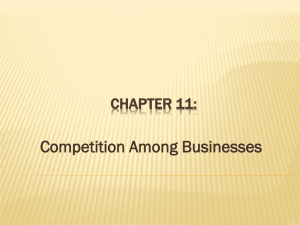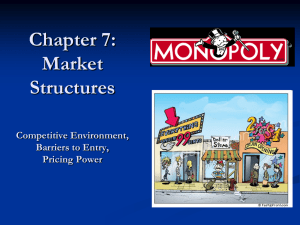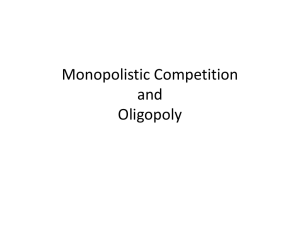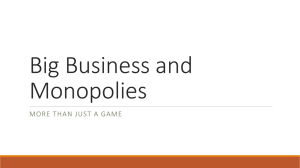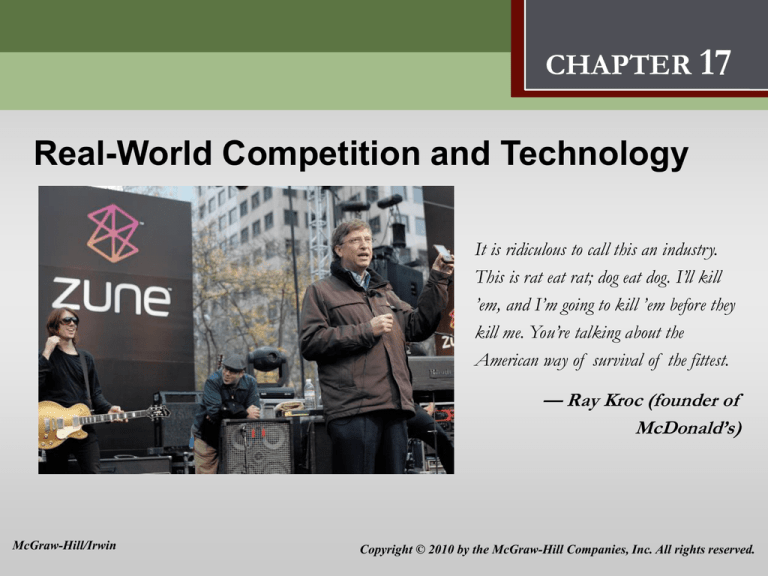
CHAPTER 17
Real-World Competition and Technology
It is ridiculous to call this an industry.
This is rat eat rat; dog eat dog. I’ll kill
’em, and I’m going to kill ’em before they
kill me. You’re talking about the
American way of survival of the fittest.
— Ray Kroc (founder of
McDonald’s)
McGraw-Hill/Irwin
Copyright © 2010 by the McGraw-Hill Companies, Inc. All rights reserved.
Chapter Goals
• Discuss the monitoring problem and its implications for
economics
• Explain how corporate takeovers can limit X-inefficiency
• Discuss why competition should be seen as a process,
not a state
• Explain two actions firms take to break down monopoly
and three they take to protect monopoly
• Discuss why oligopoly is the best market structure for
technological change
17-2
Pretest
1. When firms operate less efficiently than they could technically, they are
called:
A) Y-inefficient.
B) M-firms.
C) monopolistic minimizers.
D) X-inefficient.
Definition of x-inefficiency
2. Managers often react to the threat of a corporate takeover by:
A) becoming more efficient.
B) becoming more lazy.
C) doing nothing.
D) reducing the company's debt load.
Threat of corporate takeover, because it may mean a loss of job for managers,
makes managers more efficient.
3. Which of the following is an example of a legal monopoly?
A) A patent.
B) A price support.
C) A tariff.
D) A subsidy.
A patent gives the holder the legal right to be the sole supplier.
4. A shoe producer goes to a shoe store, buys a pair of a competitor's shoes,
takes them back to his/her plant, and disassembles them to gain information
about the shoes. This is called:
A) reverse engineering.
B) monitoring.
C) deconstruction.
D) information engineering.
Definition of reverse engineering
5.
A)
B)
C)
D)
Critics of the regulation of natural monopolies contend that:
regulated firms may become too efficient.
regulated firms may inflate costs.
society cannot rely on direct competitive forces.
there is no incentive for regulated firms to develop capital-intensive projects.
Since regulators set price relative to costs, natural monopolies have an incentive
to boost costs.
6. Firms are most likely to focus on establishing market position if:
A) the market is perfectly competitive.
B) it is a winner-take-all market in the long run.
C) there are diseconomies of scale.
D) it is a lazy monopolist.
In a winner-take-all competition, the winner, once established, achieves a
monopoly and can charge significantly higher prices than its cost without facing
competition. Competition to establish market position is fierce.
7. The market structure that economists believe to be the most dynamically
efficient and promote technological advancement is:
A) perfect competition.
B) monopolistic competition.
C) oligopoly.
D) monopoly.
Oligopolists have the funds to carry out research and development and feel the
pressure from competitors to innovate.
8. The most likely reason the U.S. government offers patent protection on
major innovations is that:
A) this creates a strong incentive for firms to innovate.
B) firms with patents earn higher profits and can pay higher taxes.
C) markets operate more efficiently when economic profits are positive.
D) the firm holding a patent will become a monopoly, which is a market
structure associated with greater efficiency than any of the others.
The promise of patent protection encourages innovation because firms need not
fear that the profits resulting from an innovation will be competed away
9. A network externality occurs when:
A) greater use of a product increases the benefit of that product to everyone.
B) greater use of a product reduces the benefit of that product to everyone.
C) the effect of a decision on a third party is taken into account by the
decision-maker.
D) there are no effects of a decision on any third parties.
Definition of a network externality.
10. Technological lock-in occurs when:
A) more efficient technologies replace less efficient ones.
B) less efficient technologies replace more efficient ones.
C) prior use of a technology makes the adoption of subsequent technologies
difficult.
D) prior use of a technology makes the rewards for subsequent innovations
greater.
For example, the standard QWERTY keyboard.
Short-Run vs. Long-Run Profit
• Firms care about both short-run and long-run profit
• Firms may not take full advantage of a potential
monopolistic situation in the short run to strengthen
their position in the long run
• Any expenditures on building a brand and a good
reputation can reduce short-run profits but increase
long-run profits
17-6
Managers’ Incentives and the Need for Monitoring
• Managers have an incentive to keep costs down, but their
salaries are included in costs
• This creates a monitoring problem which is the
need to oversee employees to ensure that their
actions are in the best interest of the firm
• Employees’ incentives differ from the owner’s
incentives
• To address this problem, firms sometimes give managers
incentive-compatible contracts in which the incentives
of each of the two parties to the contract are made to
correspond as closely as possible
17-7
CEO Compensation
Company
CEO Compensation in 2007 ($)
Oracle
556,980,000
Occidental Petroleum
222,640,000
HESS
154,580,000
Ultra Petroleum
116,930,000
EOG Resources
90,470,000
WR Berkley
87,980,000
Burlington Santa Fe
68,620,000
Alleghery Energy
67,260,000
Monsanto
64,600,000
Deere & Co
61,300,000
Self-interested
managers will
maximize firm
profit only if the
structure of the
firm requires them
to do so
17-8
What Do Real-World Firms Maximize?
• Firms have complicated goals that reflect the organizational
structure and incentives built into the system
• Although profit is one goal of a firm, often firms focus on
other intermediate goals such as cost and sales
• Some firms do not push for cost efficiency and become
lazy monopolists
• Lazy monopolists are firms that do not push for
efficiency, but merely enjoy the position they are
already in
17-9
The Lazy Monopolist and X-Inefficiency
• Lazy monopolists are not profit maximizers
• They perform as efficiently as is consistent with keeping
their jobs
• The result is called X–inefficiency where firms operate
far less efficiently than they technically could
• Such firms have monopoly positions, but they don’t
make large monopoly profits which can result in earning
normal profits or even a loss
17-10
How Competition Limits the Lazy Monopolist
• New firms or international competition can push lazy
monopolies to be more competitive
• Corporate takeovers, or the threat of one, can improve
efficiency
• A corporate takeover is when another firm or group
of individuals issues a tender offer (buy the stock) to
gain control and install its own managers
• Nonprofit organizations may display lazy monopolist
tendencies
17-11
True Cost Efficiency and the Lazy Monopolist
P
MC
ATCInefficient
CL
CLM B
ATCEfficient
A
CM
D
MR
QM
An inefficient (lazy)
monopolist would
have higher costs and
earn only B profit
An efficient monopolist
would have
lower costs and
earn A+B profit
Q
17-12
The Fight between
Competitive and Monopolistic Forces
• Competition is a process – a fight between the forces
of monopolization and the forces of competition
• Self-interest-seeking individuals don’t like competition
for themselves and may use political and social means
to fight competition
• It is important to understand how the invisible hand,
social forces, and political pressures work in order to
understand competition
17-13
How Monopolistic Forces
Affect Perfect Competition
• Laws, social values, and customs in the United States
do not allow perfect competition to work because our
government emphasizes other social goals besides
efficiency
• The Robinson-Patman Act and several state laws
prevent firms from charging a price that is too low
• The U.S. has laws, regulations, and programs that
prevent agricultural markets from working competitively
17-14
Movement Away from Competitive Markets
If suppliers of O-L can keep
suppliers of L-M out of the
market, price increases to PL
P
S
Profit increases by A
PL
PM
A
The suppliers kept out
of the market lose C in
producer surplus
B
C
Consumers lose A+B in
consumer surplus
D
O
L
M
Q
Deadweight loss is B+C
17-15
How Competition Forces Affect Monopoly
• Competitive forces work to break down monopoly by
using political or economic forces
• Lobbying to change the law protecting monopoly
• Developing a similar product without violating a
patent
• Reverse engineering is the process of a firm buying
other firms products, disassembling them, studying
them, and then copying them within the limits of the law
17-16
Competition and Natural Monopolies
• Natural monopolies are industries whose average
total cost decreases as output increases and because
of this they can make large profits
• Economies of scale can create a natural monopoly
• To prevent abuse of their market power, many natural
monopolies are regulated
• New technologies can compete with and undermine
natural monopolies
17-17
Regulating Natural Monopolies
• Regulated natural monopolies have been given the
exclusive right to operate in the industry
• In return, they are allowed to charge a fair price,
which includes all costs plus a normal return on
capital investment
• Regulation to allow regulated monopolies to earn a
normal profit
• When firms are allowed to pass on all cost increases,
they have little or no incentive to hold down costs and
X–inefficiency develops
17-18
Deregulating Natural Monopolies
• Many formerly regulated natural monopolies are
being deregulated
• In the electricity industry, power supply has been
deregulated, but because of the existence of
economies of scale, the power line industry has
remained a regulated monopoly
• Only portions of industries that are likely to be
competitive are being deregulated
17-19
How Firms Protect Their Monopolies
Monopolies spend money to maintain their monopoly by:
• Advertising
• Lobbying
• Producing goods that are difficult to copy
• Not taking advantage of their monopoly position
and charging a lower price
• Firms will buy monopoly power until the marginal cost of
maintaining the monopoly equals the marginal benefit
17-20
Establishing Market Position
• It is argued that modern competition is a winner–take–all
competition
• In winner–take–all markets, the initial competition is on
establishing market position
• The winner who achieves a monopoly can charge
significantly higher prices without facing any competition
17-21
Technology, Efficiency, and Market Structure
• Technological development is the discovery of new or
improved products or methods of production
• Because the global market is significantly larger than a
domestic one, globalization provides an incentive to
develop new technology
• Market structures that best promote technological change
are dynamically efficient
• Dynamic efficiency refers to a market’s ability to promote
cost-reducing or product-enhancing technological change
17-22
Market Structure and Technology
Perfect competition
• There is no incentive to develop new technologies
because they earn no profits to fund research
• Even if they did innovate, competitors would gain from
the new technology without having to pay for it
Monopolistic competition
• Because of market power, monopolistic competition is
more conducive to technological change
• Due to ease of entry, they lack long-run profits, so their
ability to recoup their investment is limited
17-23
Market Structure and Technology
Monopoly
• Monopolists have profits but little incentive to innovate
since they are protected by barriers to entry
Oligopoly
• May be the market structure that is most conducive to
technological change
• If competitors are innovating, it will force them to do
so as well
• They receive economic profit, oligopolists have the
money to carry out research and development
17-24
Network Externalities,
Standards, and Technological Lock–In
• Network externalities occur when greater use of a product
increases the benefit of that product to everyone
• Network externalities lead to market standards and affect
market structure
• Standards are created when a firm’s standard is accepted
and dominates the market
• First-mover advantage helps explain the high stock
prices of start-up technology companies
• Technological lock-in is when prior use of a technology
makes the adoption of subsequent technology difficult
17-25
Chapter Summary
• Profit is an important goal of firms, but actual goals
depend on the incentive structure of the firm
• The monitoring problem arises because managers’
incentives are not always to maximize the firm’s profit
• Incentive-compatible contracts help alleviate the
monitoring problem
• Monopolists facing no competition can become subject
to X-inefficiency – operating less efficiently than is
technically possible
17-26
Chapter Summary
• X-inefficiency can be limited by the threat of competition
or takeovers
• Firms will spend money on monopolization until the
marginal cost equals the marginal benefit
• Firms protect their monopolies by advertising, lobbying,
and producing products that are difficult to copy
17-27
Chapter Summary
• Firms compete against patents that create monopolies
by making slight modifications to existing patents and
engaging in reverse engineering
• The U.S. is deregulating the portions of natural
monopolies where competition is feasible
• Oligopoly is the best market structure for technological
advance because oligopolists have an incentive to
innovate since they can earn economic profits, which
can also be used to invest in research and development
17-28



